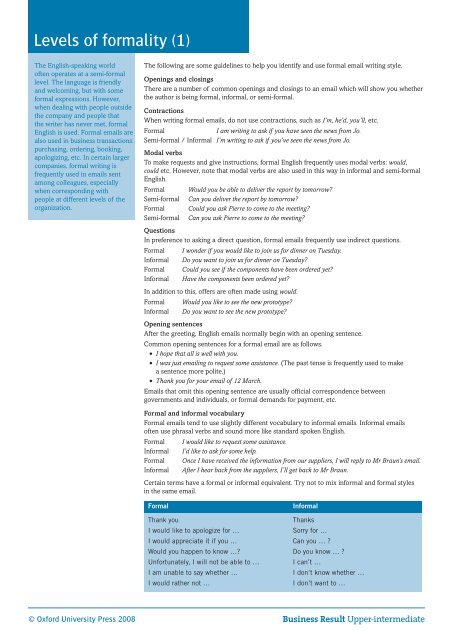brupp_formality
You also want an ePaper? Increase the reach of your titles
YUMPU automatically turns print PDFs into web optimized ePapers that Google loves.
Levels of <strong>formality</strong> (1)<br />
The English-speaking world<br />
often operates at a semi-formal<br />
level. The language is friendly<br />
and welcoming, but with some<br />
formal expressions. However,<br />
when dealing with people outside<br />
the company and people that<br />
the writer has never met, formal<br />
English is used. Formal emails are<br />
also used in business transactions:<br />
purchasing, ordering, booking,<br />
apologizing, etc. In certain larger<br />
companies, formal writing is<br />
frequently used in emails sent<br />
among colleagues, especially<br />
when corresponding with<br />
people at different levels of the<br />
organization.<br />
The following are some guidelines to help you identify and use formal email writing style.<br />
Openings and closings<br />
There are a number of common openings and closings to an email which will show you whether<br />
the author is being formal, informal, or semi-formal.<br />
Contractions<br />
When writing formal emails, do not use contractions, such as I’m, he’d, you’ll, etc.<br />
Formal<br />
I am writing to ask if you have seen the news from Jo.<br />
Semi-formal / Informal I’m writing to ask if you’ve seen the news from Jo.<br />
Modal verbs<br />
To make requests and give instructions, formal English frequently uses modal verbs: would,<br />
could etc. However, note that modal verbs are also used in this way in informal and semi-formal<br />
English.<br />
Formal<br />
Semi-formal<br />
Formal<br />
Semi-formal<br />
Would you be able to deliver the report by tomorrow?<br />
Can you deliver the report by tomorrow?<br />
Could you ask Pierre to come to the meeting?<br />
Can you ask Pierre to come to the meeting?<br />
Questions<br />
In preference to asking a direct question, formal emails frequently use indirect questions.<br />
Formal<br />
Informal<br />
Formal<br />
Informal<br />
I wonder if you would like to join us for dinner on Tuesday.<br />
Do you want to join us for dinner on Tuesday?<br />
Could you see if the components have been ordered yet?<br />
Have the components been ordered yet?<br />
In addition to this, offers are often made using would.<br />
Formal<br />
Informal<br />
Would you like to see the new prototype?<br />
Do you want to see the new prototype?<br />
Opening sentences<br />
After the greeting, English emails normally begin with an opening sentence.<br />
Common opening sentences for a formal email are as follows.<br />
• I hope that all is well with you.<br />
• I was just emailing to request some assistance. (The past tense is frequently used to make<br />
a sentence more polite.)<br />
• Thank you for your email of 12 March.<br />
Emails that omit this opening sentence are usually official correspondence between<br />
governments and individuals, or formal demands for payment, etc.<br />
Formal and informal vocabulary<br />
Formal emails tend to use slightly different vocabulary to informal emails. Informal emails<br />
often use phrasal verbs and sound more like standard spoken English.<br />
Formal I would like to request some assistance.<br />
Informal I’d like to ask for some help.<br />
Formal Once I have received the information from our suppliers, I will reply to Mr Braun’s email.<br />
Informal After I hear back from the suppliers, I’ll get back to Mr Braun.<br />
Certain terms have a formal or informal equivalent. Try not to mix informal and formal styles<br />
in the same email.<br />
Formal<br />
Thank you<br />
I would like to apologize for …<br />
I would appreciate it if you …<br />
Would you happen to know …?<br />
Unfortunately, I will not be able to …<br />
I am unable to say whether …<br />
I would rather not …<br />
Informal<br />
Thanks<br />
Sorry for …<br />
Can you … ?<br />
Do you know … ?<br />
I can’t …<br />
I don’t know whether …<br />
I don’t want to …<br />
© Oxford University Press 2008 Business Result Upper-intermediate
Levels of <strong>formality</strong> (2)<br />
Mistakes and apologies<br />
Formal and semi-formal emails are also often used between people who know each other well<br />
when the writer is apologizing for a mistake. They are also used when a more senior colleague<br />
is being copied into the correspondence. Here are some common phrases used to start an<br />
apologizing email.<br />
• I am extremely sorry for the inconvenience caused. (formal)<br />
• I am writing in order to apologize for … (formal)<br />
Example I am writing in order to apologize for the unfortunate mistake which occurred<br />
last week regarding the meeting in Paris.<br />
• Please accept our apologies.<br />
Example Please accept our apologies for the late delivery of your order.<br />
• I am very sorry that … (formal / semi-formal)<br />
Example I am very sorry that your shop has not yet received the order.<br />
• Please accept our apologies once again. (formal / semi-formal – used as the sign-off to<br />
an email with an apology)<br />
Formal<br />
May I make a request?<br />
I appreciate that this will be difficult for you.<br />
Would you be able to attend a meeting on the<br />
4 th of June?<br />
Please contact me at any time.<br />
I would like to apologize for …<br />
Informal<br />
Could I ask you for something / some<br />
help?<br />
I know that this is not going to be easy.<br />
Can you meet up on the 4 th of June?<br />
Feel free to call any time.<br />
Sorry for …<br />
© Oxford University Press 2008 Business Result Upper-intermediate




